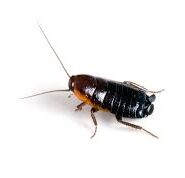Oriental cockroach
Blatta Orientalis

Key Features:
The male cockroaches are approximately 25mm long with females 32mm long.
Both sexes are shiny and very dark brown, nearly black, in appearance. However, the early instar nymphs may be reddish-brown.
The distinctive shape of the wings is noticeable in this species. In the males they cover approximately two thirds of the abdomen, whereas those of the female are vestigial.
Biology:
The female Oriental cockroach carries the ootheca for about 30 hours, after which time she deposits them, dropping or attaching them near to a food source.
Ootheca hatch in approximately six weeks, but this period may be greatly extended in cool conditions. In this situation the egg case represents a biological time bomb waiting to hatch and continue an infestation. For this reason repeated use of insecticides may be needed.
Adult size: 20-24 mm
Number of moults: 7-10
Development time: (Egg to adult) 6 months – 2 years
Length of adult stage: 3-6 months
No of ootheca produced: Average 11
in female lifetime: Range 1-18
No of eggs produced per ootheca: 16-18
Number of moults: 7-10
Development time: (Egg to adult) 6 months – 2 years
Length of adult stage: 3-6 months
No of ootheca produced: Average 11
in female lifetime: Range 1-18
No of eggs produced per ootheca: 16-18
Significance:
This is the most common cockroach in the United Kingdom.
It is found throughout the world although its status as a pest varies, for example in the USA, it is considered to be a pest of gardens primarily, from where it wanders into property.
Oriental cockroaches are poor climbers on smooth surfaces, which may limit their distribution within a building.
They appear to be cold tolerant in that they are often found outside buildings, in drains, gardens, sewers, external brickwork etc, a factor which should be remembered when attempting to control
them.
